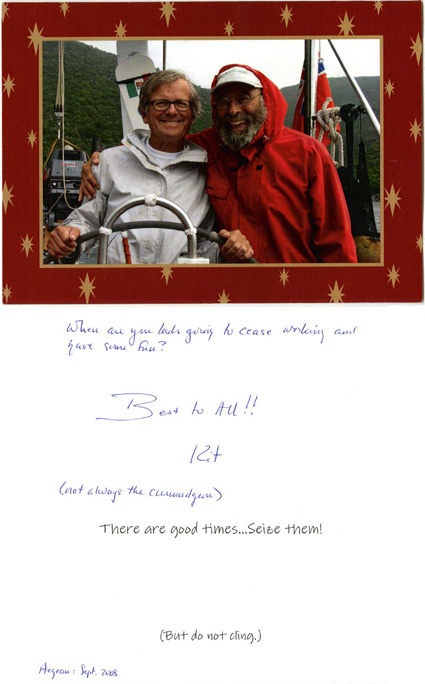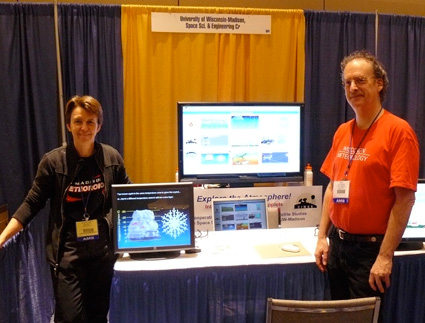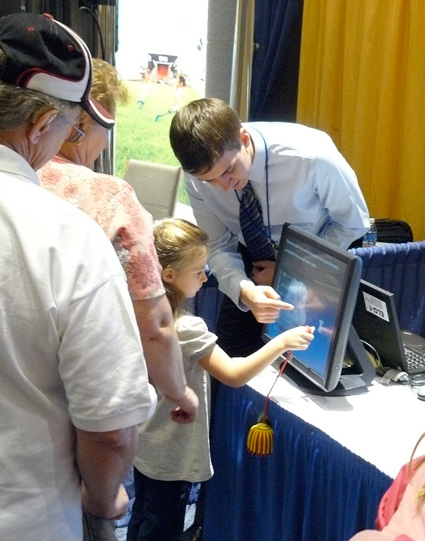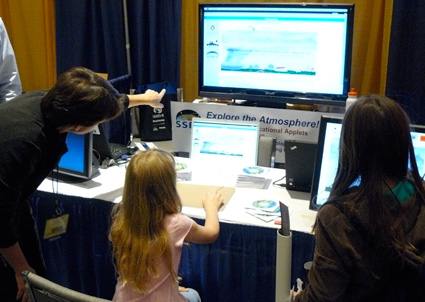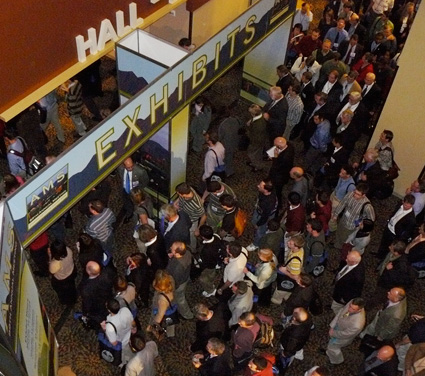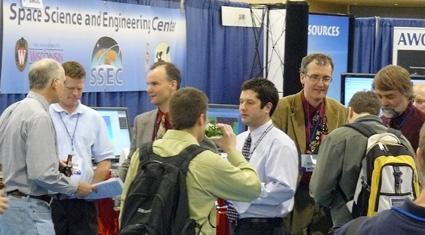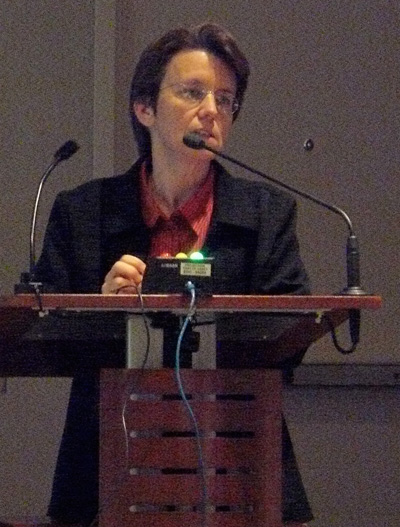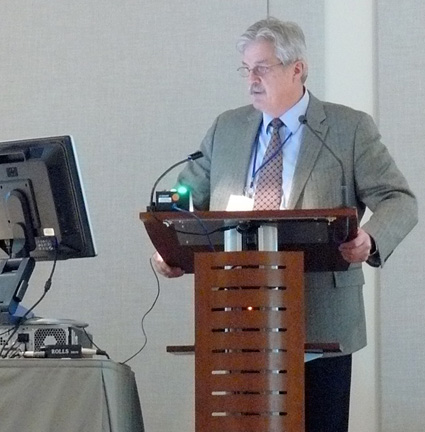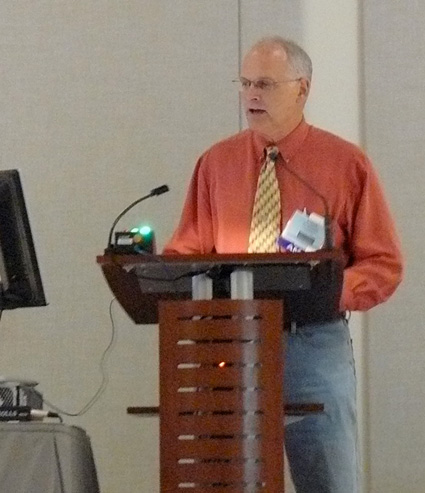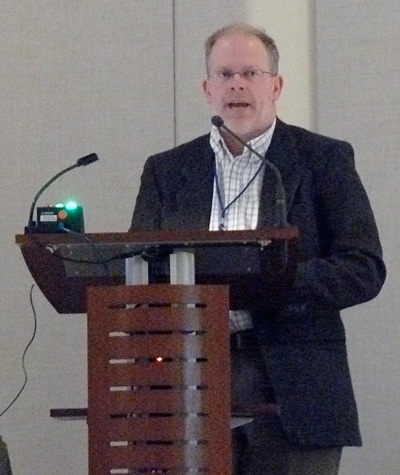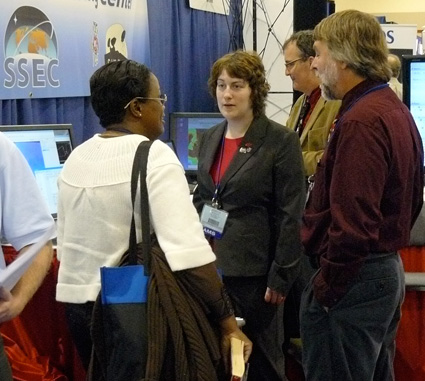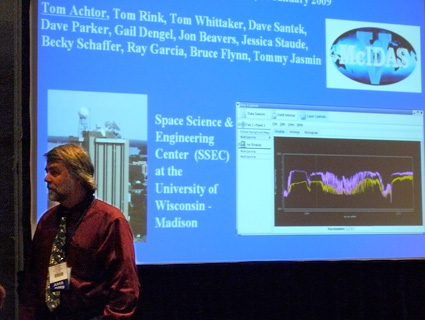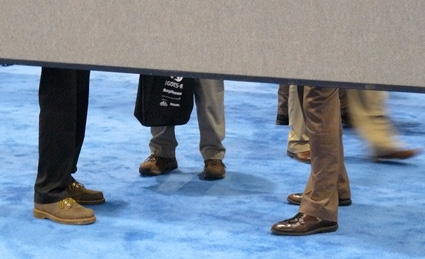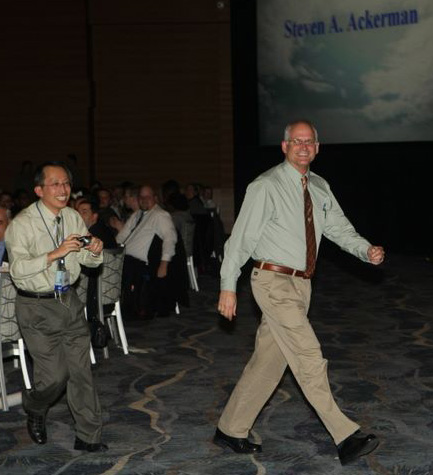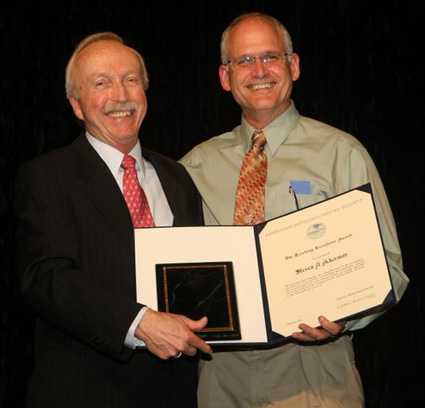Monthly News Summary – January 2009
- AERI Article Published in WAF
- Bronze Medals Awarded by NOAA
- Andrew Heidinger Elected to International Radiation Commission
- New Beta Version of McIDAS-V Now Available!
- The State of the Center Address
- Holiday Greetings from Kit Hayden
- WeatherFest
- SSEC at the American Meteorological Society 89th Annual Conference
- Steve Ackerman – AMS Teaching Excellence Award
- Tommy Jasmin Article in The Earth Scientist
Congratulations to Tim Wagner (working on his PhD with Dave Turner) on an AERI article recently published in the AMS journal, Weather and Forecasting:
The Temporal Evolution of Convective Indices in Storm-Producing Environments
Timothy J. Wagner, Wayne F. Feltz, and Steven A. Ackerman
The article addressed temporal changes in stability and shear associated with the development of thunderstorms quantified by using the enhanced temporal resolution of combined Atmospheric Emitted Radiance Interferometer (AERI) thermodynamic profile retrievals and National Oceanic and Atmospheric Administration (NOAA) 404-MHz wind profiler observations.
NOAA Bronze Medal awards for 2008 were awarded to Andrew Heidinger, Tim Schmit, and Jeff Key of the Advanced Satellite Products Branch. Heidinger and Key were part of a group award (with R. Ferraro, T. Smith, M. Eakin, and K. Gallo, NESDIS) for “innovative uses of operational weather satellites to understand climate change and to quantify trends in the global climate system.” Schmit was part of a group award (with A. Powell, M. Crison, R. Kuligowski, D. Tarpely, J. Pereira, I. Guch, D. Hermreck, L. Flynn, F. Weng, L. Miller, V. Griffin, S. Goodman, and J. Yoe, NESDIS) for “developing NOAA’s Strategic Satellite Plan to balance requirements, observation capabilities, and resources.”
Andrew Heidinger Elected to International Radiation Commission
Andrew Heidinger was elected to a four-year term on the International Radiation Commission (IRC). The IRC is the oldest subgroup of the International Association of Meteorology and Atmospheric Sciences (IAMAS). The role of the IRC is to promote research into atmospheric radiation as well as the application of that research to practical problems.
New Beta Version of McIDAS-V Now Available
The newest version of McIDAS-V, version 1.0beta1, is now available for free download from the McIDAS Website:
http://www.ssec.wisc.edu/mcidas/software/v
The release of McIDAS-V version 1.0beta1 showcases the results of our work in a few main areas of development:
- improving the user interface, including adding a tabbed window display, and improving the consistency between the different data choosers
- improving access to ADDE servers, so that remote servers are easier to organize and import into McIDAS-V, and so that most of the ADDE servers available in McIDAS-X for local image data are also available as local ADDE servers in McIDAS-V
- creating a “bridge” to McIDAS-X, allowing -X users with legacy code (or other functionality that has not yet been ported to -V) to continue to use that code in -X, while doing their visualization in McIDAS-V
- importing the functionality of SSEC’s HYDRA software package into McIDAS-V for interrogating hyperspectral and multispectral satellite data
- importing the functionality of McIDAS-X, including local ADDE servers and the addition of eleven image filter formulas
- improving the McIDAS-V User’s Guide and creating tutorials for new users
Future development will include continuing to add functionality to McIDAS-V, developing more training materials, and continuing to improve the user interface and the performance of McIDAS-V.
If you’re new to McIDAS-V, a collection of eight McIDAS-V tutorials are available at the bottom of the McIDAS-V Information page. The “Getting Started” chapter in the McIDAS-V User’s Guide will also help to guide you through using the different types of data available with McIDAS-V.
For current McIDAS-V users, there have been several notable changes since 1.0alpha13. The HYDRA functionality has been updated to work with 500m and 250m MODIS images and to support multiple colors in the Scatter Analysis, which allows you to create a scatter plot between two data sources with the same geographical domain. Other changes include more consistency in the look and feel of the data choosers, additional local ADDE servers, and updated documentation.
Remember — this is still a beta version of McIDAS-V, which means that there may be bugs in the software that we have not yet found or fixed. It also means that if you’re interested in providing input into the development of McIDAS-V, there is still time to have your voice heard! We’re always looking for user feedback, so if you see something that’s not working correctly or some functionality that you’d like to see added, please send a support request to McIDAS-V Support or use the Support Request Form in the Help menu of McIDAS-V.
Along with the release of McIDAS-V version 1.0beta1, we are also pleased to announce the opening of the McIDAS-V Support Forums:
http://www.ssec.wisc.edu/mcidas/forums
Public Forums
Registration to these forums is free, and is also required in order to post to the forums. At this time, there is no registration required to view the posts located in the public forums. If you encounter problems that the McIDAS-V User’s Guide or forums do not address, you are encouraged to post your questions to the McIDAS-V Support Forums. In turn, other users are encouraged to respond to the posts.
Private Forum
There is also a McIDAS Users’ Group Support forum that is only visible to known members of the McIDAS Users’ Group (MUG), and is the only forum closely monitored by the McIDAS Help Desk. After registering in the forum, MUG members should notify the McIDAS Help Desk with their forum username and McIDAS site. Once their MUG membership is verified, they will be given access to the McIDAS Users’ Group Support forum.
The McIDAS Help Desk is staffed during business hours with user-support personnel. As noted in the MUG Policy Document, the help desk is supported by the fees paid by the McIDAS Users’ Group (MUG) and thus provides advanced-level support for MUG members. For McIDAS-V all users (whether or not a MUG member) are welcome to contact the help desk to report software bugs or suggest improvements (enhancements).
We look forward to hearing your feedback!
The State of the Center Address
On December 12, 2008, Hank Revercomb gave his annual State of the Center Address to a capacity crowd at the Educational Science Building. To access this (or previous) State of the Center addresses in either Powerpoint or .pdf formats, go to:
http://www.ssec.wisc.edu/state-of-center/
Holiday Greetings from Kit Hayden
Here is a Christmas card sent by the former Fed-in-charge (from about 10 yrs ago), Kit Hayden.
On the Sunday before the AMS Conference in Phoenix officially opened, the 8th Annual WeatherFest convened, featuring more than 65 interactive meteorology, oceanography and related science exhibits specifically created to instill interest in math and science in children of all ages. Margaret Mooney, Tom Whittaker and Luke Schiferl ran the SSEC booth, helping crowds of fascinated children (and their parents) navigate several weather-related applets created at SSEC. Plenty of local TV coverage, raffles and appearances by penguins, alligators and Smokey the Bear kept the room jumping. Judging from the enthusiastic crowds and the lines of excited children and happy parents waiting to try their hand at the SSEC applets, the goals of WeatherFest were achieved!
Margaret Mooney and Tom Whittaker
Luke Schiferl guides a future scientist
Margaret demonstrates an applet
SSEC at the American Meteorological Society 89th Annual Conference
For five days in January the topic at the Phoenix Convention Center was “Urban Weather and Climate: Now and in the Future.” The 89th Annual AMS Conference hosted over 2500 of the world’s leading atmospheric scientists to discuss weather and climate-related topics. SSEC showed up with a strong presence – over 40 participants and over 50 presentations and posters.
After a strong opening at WeatherFest on Sunday (and a lovely evening enjoying the shirt-sleeve weather), Monday was a day of booth set up and adjustment until 5:30 p.m., when the blue ribbon was cut, the Exhibit Hall officially opened and the gala reception began. The hall was packed, filled with aromas from the buffet and the excited conversations of exhibitors and attendees. The SSEC booth was popular, lively with discussion and friendly banter. Over the next three days, the exhibit hall, and the SSEC booth, saw a steady stream of interested visitors. The poster sessions were consistently well-attended as well.
Scott Lindstrom and Jessica Staude evidently spent 24 hours per day at the SSEC booth, giving demonstrations and answering questions about the new beta version of McIDAS-V and the MODIS Google Earth display.
“If you exhibit, they will come…”
The booth at high tide
Margaret Mooney on “Promoting Climate Literacy through K-12 Professional Development Opportunities”
Paul Menzel on “International Training Events and Educational Seminars on Satellite Remote Sensing”
Steve Ackerman asks “After More Than 10 Years of e-Learning, What Have We Learned?”
Scott Bachmeier on “Satellite Training Activities at CIMSS: Helping to Prepare Forecasters of the GOES-R and NPOESS Era”
Jess, Scott and Tom still busy at the booth
Tom Achtor prepares to spread the word about McIDAS-V
Jordan Gerth (left) presents his poster
Steve Ackerman — AMS Teaching Excellence Award
To thunderous applause from assorted rowdies at the SSEC table, Steve Ackerman accepted the AMS Teaching Excellence Award at the 89th Annual AMS Conference.
Allen Huang – paparazzo? Steve Ackerman – celeb?
Steve Ackerman receives his AMS Teaching Excellence Award
Tommy Jasmin Article in The Earth Scientist
Tommy Jasmin’s article, “Satellite Observations in Science Education – A Free Toolkit for Developing Scientific E-Learning Activities” has been published in the Fall/Winter 2008 issue of the The Earth Scientist, the journal of The National Earth Science Teachers Association. Jasmine’s article describes a toolkit of Reusable Content Objects developed by Satellite Observations in Science Education (http://www.ssec.wisc.edu/sose/) here at SSEC. To download the article, go to http://www.nestanet.org (membership required).

